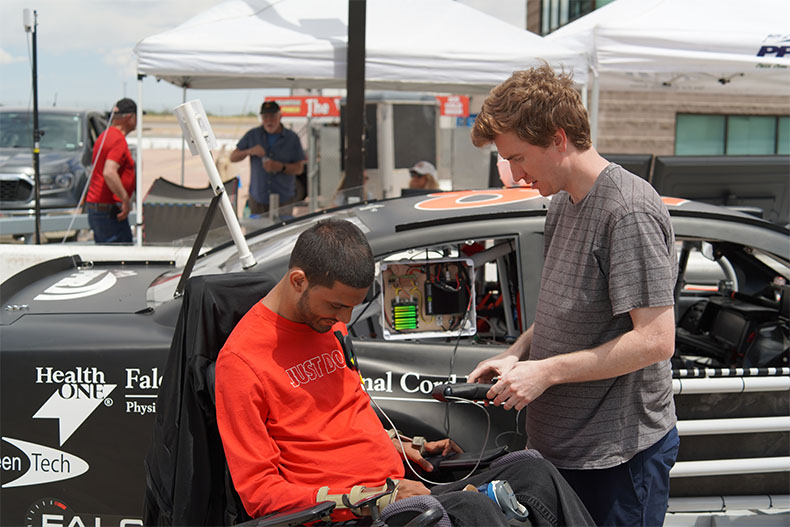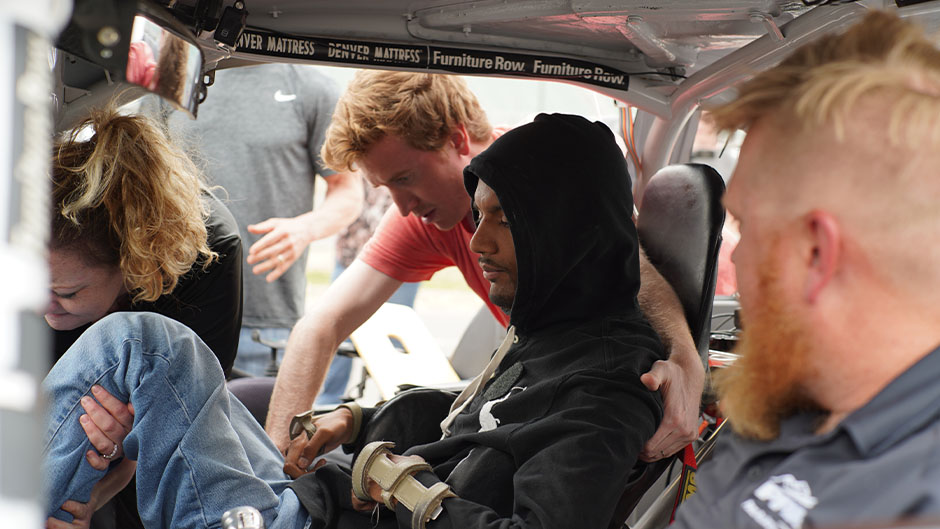“It’s satisfying,” Davis said, “to see what I’ve been working on manifest in an expression of joy on his face.”
German Aldana Zuniga, 25, became disabled at 16 after a devastating car crash. University of Miami researchers at the College of Engineering and the Miami Project to Cure Paralysis at the Miller School of Medicine collaborated with Falci Adaptive Motorsports to put Zuniga in the driver’s seat of a race car he could control with his thoughts.
Zuniga drove laps around a NASCAR track in Colorado Springs in May, but the project started years ago. In November 2018, Zuniga volunteered to undergo a brain surgery where researchers placed electrodes on the area of the brain responsible for movement of his right hand. The team sought to understand the neural signals corresponding to specific movements.
Kevin Davis enrolled in the MD/Ph.D. program at the College of Engineering Department of Biomedical Engineering and joined the project in summer of 2019. To make research participation easier on Zuniga, Davis developed a smartphone app that allowed Zuniga and his family to conduct data collection sessions from home.
“For example,” Davis said, “the app will tell him ‘Think about moving’ or ‘Think about rest.’ We use machine-learning models to map his thoughts to the signals.” The app became crucial to the life of the project as the COVID-19 pandemic made traditional lab sessions impossible. “They just click a button on the app. It records his neural signals and sends us the raw data directly.”

The day at the track
Falci Adaptive Motorsports had developed a vehicle that allows a driver to accelerate by puffing air into a straw, slow down by sipping the straw, and steer using a helmet equipped with a gyrometer. Davis’ project hinged on substituting this system for one that controlled the car using Zuniga’s thoughts.
Davis and the rest of the team flew with Zuniga to Denver and drove down to Colorado Springs in an adaptive van. Harry Direen, Ph.D., from Falci Adaptive Motorsports installed a dashboard screen that could essentially display Zuniga’s thoughts, indicating when he was, for example, accelerating.
For now, the signals are binary, Davis says. “What we’ve been primarily using it for is on and off. Think about it as a button. The rate at which you go forward is constant, so you’re holding the ‘button’ for as long as you want to go forward.” The next frontier for the team, Davis says, is learning how to allow Zuniga to modulate his speed, allowing him to travel at a range of speeds using his thoughts. They would first like to achieve this using his wheelchair before adapting it to the race car.
Fabrice Manns, professor and chair of the Department of Biomedical Engineering, said, “The story shows that there are no limits to the innovation and impact that can be achieved when engineers and surgeons team up to tackle what may seem like an impossible challenge. It is especially satisfying that the project involved engineering and medical students and trainees who will soon start their own careers as the next generation of interdisciplinary clinicians and engineers.”
The future of the project
“One of the things I’m really interested in is maximizing the function of this,” Davis said. He has updated the app with a variety of hand and arm movements as GIFs for Zuniga to replicate. Mapping the neural signal patterns corresponding to these movements could, in the future, allow the creation of a prosthetic sleeve that can help people with disabilities move in new ways. “This may be able to be used as a rehabilitative device that one trains with over time to regain function. It’s a hypothetical at the moment but it’s something I’m very interested in.”
Zuniga’s progress, Davis said, is exciting and should serve as encouragement for others to get involved in the research process. Results can never be guaranteed, but the more participants join similar research projects, the more widely applicable the innovations can become.
“It’s very humbling to be a cog in the big machine that helps move this work forward. I’ve been inspired by German and his motivation. It’s been very special to work with him, irrespective of the groundbreaking milestones we’ve reached,” Davis said. “It’s satisfying to see what I’ve been working on manifest in an expression of joy on his face.”

